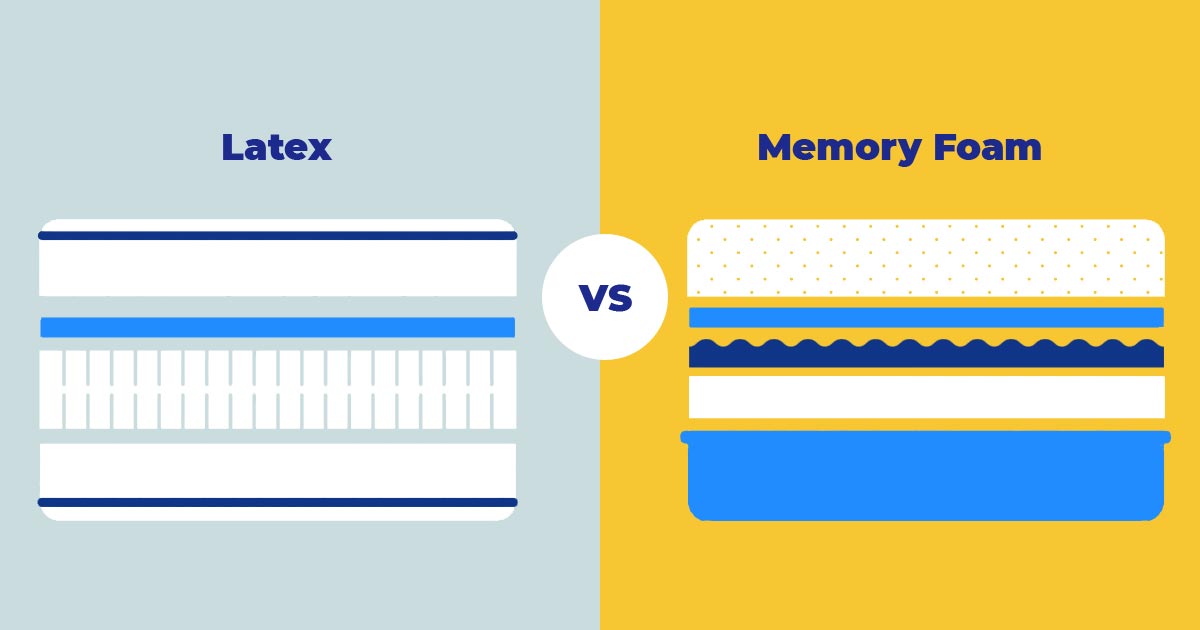Memory Foam VS Latex Mattress: What’s Your Bed Choice?

Have you been perplexed by a flurry of facts concerning the most recent mattress advancements, and are unable to tell what’s real and what isn’t?
So many manufacturers and merchants use terminology like memory foam and latex to advertise their goods and their benefits. It’s time to dispel the myths and fallacies.
Let’s clear up any misunderstandings and figure out what the differences are between memory foam and latex mattresses.
The Concepts
Memory Foam
NASA was the first to use memory foam in the 1960s. In the mid-1960s, aeronautical engineer Charles Yost invented memory foam under a NASA contract to protect pilots during accidents.
It’s polyurethane that’s been formulated using a variety of ingredients. These compounds produce a substance that is very dense and absorbent of energy.
Memory foam was originally utilized in mattresses in the early 1990s, but it was the bed-in-a-box mattress concept that made it popular. For fast and convenient distribution, companies compress and roll memory foam mattresses into boxes. This sort of foam conforms to your body’s unique contour. It’s pliable, long-lasting, and known for its capacity to absorb impact. This implies that if you share a bed with someone, you won’t be able to tell whether they’re tossing and turning all night.
The recuperation period with memory foam is substantially longer. When you press your body into the material and raise it up, the material will not rapidly return to its former shape. When memory foam is added to top layers, this fact contributes to its comfort and support. Most top mattress companies utilize some sort of memory foam in their mattresses since manufacturers realized the amazing benefits this material can provide to those who suffer from back or joint problems.
Sub-categories in the Mattress Manufacturing Process
There are three different types of memory foam mattresses:
Foam in the traditional sense: Memory foam mattresses have a closed-cell construction that retains heat and polyurethane that conforms to the body.
Open-cell foam: It is made up of “open cells” that allow air to circulate freely throughout the mattress. It has a softer and less thick feel than typical foam mattresses.
Gel pods in foam: Gel pods are put to the top layer of such mattresses to provide an extra layer of support and comfort. These gel pods also help the mattress feel more bouncy than traditional and open-cell foam alternatives. You can expect a soft, lasting feel from whatever memory foam mattress you purchase, as well as support for hurting joints. It has a medium to hard stiffness and lasts for 8–10 years on average.
Latex
Latex differs from memory foam in that it has a much faster recovery time and a lot more bounce. When you push your hand into a latex mattress and then lift your hand up, the mattress immediately returns to its previous shape.
For mattresses, there are two distinct varieties of latex.
Natural Latex: This variety is the purest of its kind, as it originates from the sap of rubber trees. It may be created at a low cost and is an excellent alternative for someone looking for an all-natural solution.
Synthetic Latex: This is a distinct sort of rubber that is made from a variety of synthetic components. The most noticeable distinction between synthetic and pure latex mattresses for consumers of synthetic latex beds is that the synthetic version has less bounce and can feel more like a memory foam choice.
Sub-categories in the Mattress Manufacturing Process
These beds are made out of two types of latex manufacturing processes: Dunlop and Talalay.
The words “Talalay” and “Dunlop” relate to the production procedures that these materials go through. The starting material is the same, but the production process is vastly different.
The Dunlop method is easier and Dunlop latex products are often less costly than Talalay latex. The Talalay technique, on the other hand, is significantly more complicated, but ultimately results in a softer, less thick latex that is better suited for particular uses.
Many mattress manufacturers employ both types of latex in their products, so you can wind up with a bed that has both Talalay and Dunlop latex. It is better for the support core of a mattress because of its higher density and firmness, whilst Talalay latex is better for the comfort layers because of its softer feel.
Dunlop Latex Manufacturing Process
Dunlop was the first latex foam manufacturing technique. It was initially created in 1929, and the method has remained mostly unchanged since then. Dunlop latex is made in the following way:
- To make frothy foam, liquid latex extract is manually beaten.
- The foamy substance is poured into a mold.
- In a vulcanization oven, the material is cooked.
- The baked latex is carefully removed from the mold and properly cleansed.
- To eliminate moisture, the material is baked once again.
This procedure results in thick, hard foam. The material is also unevenly distributed, resulting in a “bottom-heavy” composition with a stiffer bottom than a softer top. This composition is good for support cores in mattresses, however it is not recommended for comfort layers. However, Dunlop latex is modified and used in the comfort layers of a variety of mattress types.
Talalay Latex Manufacturing Process
The Talalay method is a little more complicated. It was created in the 1940s and has undergone several revisions throughout the years. The present procedure is as follows:
- To make frothy foam, liquid latex extract is manually beaten.
- The foam is poured into a mold, but it is only half filled.
- When the filled mold is vacuum-sealed, the latex expands.
- The filled mold is then immediately frozen, allowing carbon dioxide to pass through the latex.
- To set the frozen substance, it is baked.
- The latex is rinsed and dried after being taken from the mold.
The Talalay method produces softer, fluffier latex with a more uniform consistency. The resultant foam is softer and denser, making it appropriate for comfort layers but not support cores.
Differences between Dunlop and Talalay Latex Mattresses
Dunlop is harder and denser than Talalay. Talalay is softer, less dense, and more homogeneous in character. The following are the most visible distinctions between Talalay and Dunlop mattresses:
Neutralization of Temperature
Talalay latex is less thick and allows for better ventilation. It is more breathable than Dunlop latex. In most cases, Talalay offers significantly superior temperature neutrality as a result of this.
Cost
Dunlop is often less expensive to produce, owing to the fact that the manufacturing process is significantly less intense. This is frequently reflected in the final pricing of new mattresses, but the price difference is usually minor.
Durability
Dunlop latex is more durable than Talalay latex. This is owing to Dunlop’s substantially higher density. However, as compared to most other mattress materials, both types are quite durable.
Feel
Dunlop latex is often stronger and denser than Talalay latex. In most latex mattresses, this implies Dunlop is utilized for the support core and Talalay is used for the top comfort layers. Both variants, however, may be built to a range of firmness levels.
Environmental Resilience
Latex is regarded to be more environmentally friendly than alternatives such as memory foam, independent of the production technique. It comes from a natural, renewable source and is more durable than alternatives, resulting in a cheaper long-term environmental cost. Because the Dunlop method uses less energy, it may be more environmentally friendly than Talalay.
The Pros of Memory Foam Mattresses
Pressure Relief
Memory foam mattresses conform to the curve of the body, relieving pressure spots. Furthermore, the material adheres to the body rather than rubbing against it, reducing discomfort rather than exacerbating it..
Motion Isolation
Memory foam prevents motions from traveling across the bed due to its history as a crash material. A memory foam mattress could be a good option for restless sleepers who share a bed.
Hypoallergenic
Memory foam’s dense structure naturally resists the accumulation of dust mites and other allergens. Sleepers allergic to natural materials such as wool can also rest well on most memory foam mattresses.
Affordability
Memory foam mattresses are available at practically any price point. Many top-of-the-line memory foam mattresses are around $1000.
The Cons of Memory Foam
Retention of Heat
Memory foam’s density makes it harder for the material to dissipate body heat. Many manufacturers handle this issue by including air passages, cutouts, or conductive material infusions, like as gel memory foam, into their products.
Off-Gassing
When you first open a memory foam mattress, you may notice an unpleasant chemical odor. This is called off-gassing, caused by volatile organic compounds (VOCs) breaking down at room temperature. The aroma usually fades after three to seven days. If strong odors disturb you, search for a CertiPUR-US® certification, which indicates that the mattress has minimal levels of VOCs.
Edge Support is Inadequate
Due to the conforming nature of memory foam, most mattresses will give way to your weight if you sit on the edge. Some types firm up the sides by wrapping stiff foams around the mattress’s perimeter.
Slowness of Response
As the recipe varies by company, some memory foams are less sensitive than others. Lower-quality foams might take up to a minute to return to their original form, leaving a sleeper feeling trapped. High-quality memory foam, on the other hand, quickly returns to its original shape.
The Pros of Latex Mattress
Bounciness
Latex is a bouncy substance that makes a sleeper feel more on top of the mattress than memory foam.
Durability
Depending on the latex type, this varies. Natural latex mattresses may last up to 15 years, however mixed latex mattresses can last anywhere from 6 to 10 years. The typical memory foam mattress lasts seven years or more.
Customizable
Latex mattresses often include a side zipper that allows you to unzip the mattress and alter the firmness. This also allows you to clean the inside of the bed, which is not possible with other mattress kinds.
Organic
Natural latex mattresses are made with few to no chemicals, and collecting the ingredients has little influence on the environment. Many latex mattress manufacturers also utilize natural materials like wool and organic cotton.
Cooling
Many brands aerate the mattress for additional breathability though latex is inherently cooling. Other breathable materials, such as cotton and wool, are used in many latex mattresses.
The Cons of Latex Mattress
Too Much Bounce
When you sleep on latex, the responsive, springiness you liked may become sour. This comes true especially if you share a bed. Latex can absorb motion but not as well as memory foam at preventing it.
Initial Smell
When new, natural latex mattresses have a distinct rubbery odor. If there is wool in the bed, it may have an animal-like smell.
Weight
As a result of its density, latex is the heaviest mattress material. A queen mattress is 140 pounds on average.
A Scarcity of Supply
Latex mattresses are not commonly available in shops. Most customers must purchase one from an internet supplier. Latex mattresses are sold by fewer companies than memory foam mattresses, however the number is growing.
Price
Natural latex mattresses are one of the most costly forms of mattresses. Many queen-size models cost more than $2000.
Which Is Right for You?
Memory Foam will be the choice for folks who are:
Budget shoppers: If you’re on a tight budget, a memory foam mattress is the way to go. Synthetic latex is cheap, but it doesn’t last as long as high-quality memory foam.
Fond of a softer mattress: Memory foam is a good option if you want a softer mattress. Because of its structure, latex is firmer than memory foam.
Preferring to lie ‘in’ and not ‘on’ a mattress: Memory foam is the best choice if you want to sink into your bed.
Latex will be the choice for folks who are:
Environmentally conscious: Choose a natural latex mattress if you are concerned about the environment. Memory foam, synthetic latex, and blended latex cannot be produced without the use of petrochemicals.
Fond of a durable mattress: Choose natural latex if you want a bed that won’t sag. A natural latex mattress may last up to 15 years if properly cared for.
Preferring to lie ‘on’ and not ‘in’ a mattress: Latex is the best choice if you want to sleep on top of your mattress.









